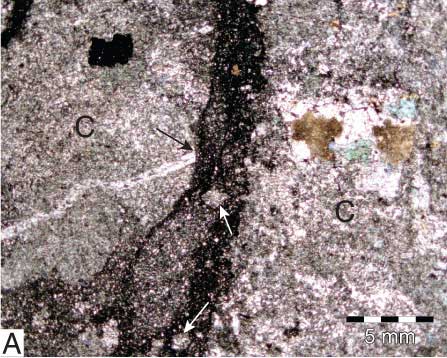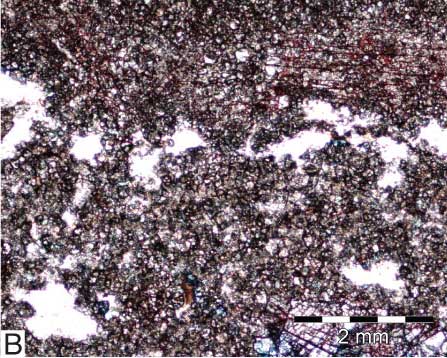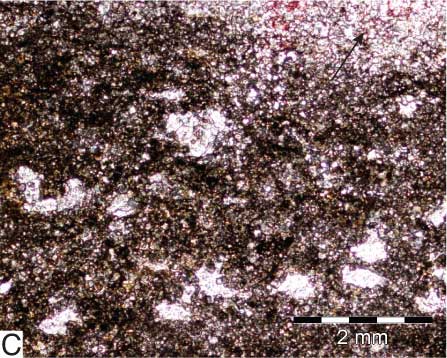Kansas Geological Survey, Current Research in Earth Sciences, Bulletin 252, part 1
Prev Page--Facies || Next Page--Controls on Deposition
Kansas Geological Survey, Current Research in Earth Sciences, Bulletin 252, part 1
Prev Page--Facies ||
Next Page--Controls on Deposition
![]()
The following section interprets environments of deposition based on features observed in cores. This section briefly discusses DS1 and SB1, but focuses on DS2 because it is the sequence that contains abundant biosiliceous (sponge spicule) and heterozoan carbonate facies interpreted to have been deposited in shallow-water environments. Additional details on DS1 and SB1 can be found in Franseen (1996), Franseen et al. (1998) and Montgomery et al. (2000). The block diagram in fig, 11 is an interpretation of the general setting of depositional environments, especially during DS2 deposition.
Figure 11--Block diagram of interpreted inner shelf/ramp depositional environments in the Schaben field study area, especially during deposition of DS2.

The abundance of the echinoderm-dominated facies containing other diverse fauna, including bryozoans, sponge spicules, brachiopods, solitary coral fragments, gastropods, and evidence of extensive reworking by burrowing organisms suggest deposition in relatively shallow subtidal, normal-marine environments. Sedimentary structures are rare, likely due to bioturbation and reworking. Fluctuating energy conditions are indicated by the interbedding of mudstone-wackestone with packstone-grainstone, locally preserved crossbedding, grain breakage, and scoured contacts. Upward decrease in thickness of EWPG beds and local preservation of crossbedding in uppermost DS1 strata may reflect a shallowing of water and increase in energy upward. The increase in MWP and SWP facies containing local evidence of primary evaporites in uppermost DS1 strata (especially in the #4 Moore core) indicate increased restriction, likely due to shallowing of water leading up to the overlying SB1 subaerial exposure event. As shown on fig. 1B, the #4 Moore core is in a position nearer the CKU, which was likely a paleotopographically high feature during deposition.
The facies and sedimentary features in DS1 are similar to those described from other Mississippian examples. Johnson and Budd (1994) described dolomudstone, dolowackestone, dolopackstone/grainstone, and lime grainstone facies dominated by echinoderms and fenestrate bryozoan fragments in nearby shelfal Meramecian strata in Kansas (Bindley field), which they interpreted to represent deposition in a normal-marine, low- to high-energy shelf environment that was periodically winnowed by storms. They noted a gradual upward increase in spicule-rich dolomudstone facies (much like DS1 strata of this study) that they interpreted to reflect increasing restriction and stress on the normal marine fauna. Witzke et al. (1990) describe Keokuk Limestone crinoidal and spicular wackestone and mudstone in Iowa that they interpret to represent quiet-water subtidal environments below fair-weather wave base and interbedded crinoid-bryozoan packstone intervals that are interpreted to record episodic bottom agitation during storm events in the middle-shelf environments. Martindale and Boreen (1997) studied Early Mississippian carbonates in southern Alberta and described inner-ramp areas dominated by structureless echinoderm grainstone shoals, which they interpreted to be due to the variable nature of storm processes and biological mixing. They also noted evidence of abundant transport in crinoidal grainstones and autocyclic shifting of facies through bedform migration in areas of constricted flow and during large storms. The storms periodically transported crinoid grains downslope as tempestite flows.
The depositional setting for DS1 is envisioned as a mostly normal to slightly restricted marine-ramp setting that was a site of growth and accumulation of skeletal and spicule material as well as allochthonous deposition characterized by autocyclic shifting of facies through migration of bedforms (sandwaves, subtidal shoals) in areas of increased currents and during storms. Some beds may represent mass-flow transport of grains downslope during storms. Some of the echinoderm wackestone, sponge spicule dolowackestone-packstone, and bioclastic dolomudstone-wackestone facies are likely indicative of lower-energy subtidal setting compared to the echinoderm-rich packstone/grainstone facies in DS1 strata. The inner shelf during DS1 deposition became increasingly restricted prior to subaerial exposure and formation of a sharp contact (SB1) between DS1 and DS2 (fig. 3). Sequence Boundary 1 is regionally extensive and it, and the strata immediately below for several meters, show significant alteration and evidence for subaerial exposure (figs. 3, 10, 12) prior to deposition of DS2 (e.g. autobreccia, clay-rich crusts with abundant horizontal fenestrae interlaminated with fine- to coarse-grained detrital quartz, branching and tapering microfractures and iron-stained oblong features interpreted to be related to roots, poikilotopic calcite cement localized in strata just below the SB1 surface; see Franseen, 1996, for more details).
Figure 12--Features associated with SB1. A) Calcite-replaced facies (C) below SB1 that were subsequently fractured and filled with very finely crystalline dolomite that contains clasts of the poikilotopic calcite (white arrows). Note the truncated coarsely crystalline calcite cement-filled fracture in the poikilotopic calcite (black arrow).

Figure 12--Features associated with SB1. B) Abundant fenestral pores (white areas) developed in dolomitic matrix just below SB1 in the # 2 Lyle Schaben core. Note pore at bottom of photo (right of center) filled with coarsely crystalline calcite cement that is common below SB1.

Figure 12--Features associated with SB1. C) Altered facies below SB1. Some oblong and tubular altered areas (soil features?) are characterized by a central area filled with coarsely crystalline calcite cement (arrow) surrounded by a hematite halo (hypocoating?) and fenestral pores (white areas) in dolomitic and replacive poikilotopic calcite matrix.

After the SB1 subaerial exposure event, marine conditions returned but the depositional environment over the study area changed compared to that for much of DS1 deposition. DS2 shows a volumetric increase of sponge-spicule wackestone and packstone (SWP) with less diverse fauna, an abundance of original early evaporites (replaced by early silica; table 3), evidence for early dolomite (table 3) and evidence of shallowest water to possibly subaerially exposed conditions (mostly fenestral fabrics; e.g. fig. 9A) throughout DS2. These features suggest deposition in more restricted environments (compared to DS1) that ranged from restricted inner shelf/protected embayment to evaporative lagoon (coastal salina?) and possibly supratidal flat. SWP and MW facies with an abundance of evaporites represent the most restricted conditions. Sponge dominance may reflect in-place accumulations where sponges thrived due to conditions inhibiting other biota (e.g. salinity, elevated silica and nutrients, cooler water temperatures) as well as shelfward transport from more open-marine environments. Local evidence of burrowing in DS2 indicates an influence of marine conditions sufficient to support some organisms that reworked the sediment during parts of DS2 deposition. Wispy and wavy horizontal lamination, alternating grain-rich and grain-poor layers, and local interbeds of grainstone in sponge-rich facies indicate transport and reworking of sediment by currents as well. Rare oncolitic coatings, wavy lamination, and micro-scale dark mottled areas may indicate some algal influence.
Thin interbeds of echinoderm-rich facies (EWPG) in DS2 are more open-marine deposits that could have resulted from several different processes. They could represent a cyclicity tied into relative sea-level changes, with the EWPG facies representing more normal-marine conditions during relative sea-level rises and highstands. Alternatively, these beds may be due to autochthonous processes such as migration of subtidal shoals or transport, including shelfward spillover deposition into a lagoon or supratidal environment, from tide or storm currents. Some of the relationships of EWPG and SWP/MW facies in DS2 (e.g., fig. 8) are similar to Holocene shallow-water saline lagoon carbonate and evaporite sediments described in the southwest Persian Gulf (Kendall and Skipwith, 1969). Shallowest water to locally subaerially exposed indicators (e.g. fenestral fabrics) that occur locally throughout DS2 could also result from several different processes, including local accumulations to sea level, evaporative drawdown, or relative sea-level falls. Distinguishing between the different possible controls for the formation of features and facies relationships within DS2 remains for future work.
One of the more significant characteristics in DS2 is the dominance of siliceous sponge-spicule facies and heterozoan carbonates that were deposited in shallow-water and restricted environments. Although it is common to think of such deposits as reflecting cold-water polar or deep basinal conditions (James, 1997), this study and others from numerous periods in the geologic record are indicating that shallow-marine, mid-latitude biosiliceous and heterozoan carbonates may be more common than previously thought (table 4). Especially interesting are the examples from Mississippian (Osagean-Meramecian) strata in North America that show similar facies associations with DS2 strata of this study (Ebanks et al., 1977; Johnson and Budd, 1994; Chowns and Elkins, 1974; Choquette et al., 1992; Lindsay, 1985).
Table 4--Shallow-water siliceous sponge associations.
| Age & Location | Facies | Characteristics & Associated Features | Depositional Environments | References |
|---|---|---|---|---|
| Ordovician, New Mexico | Ribboned chert and dolomite | Abundant siliceous sponge spicules; associated with pellets, laminated textures, stromatolites, fenestral fabrics, replaced evaporite nodules | Sabkha, intertidal to shallow subtidal | Geeslin and Chafetz (1982) |
| Devonian Caballos Novaculite | Novaculite | Sponge spicules as the sole faunal remains; fenestral fabric; small evaporite nodules and laminae | Very shallow environment in semirestricted lagoons or bays; hypersaline, reducing tidal flat areas | Folk (1973) |
| Upper Devonian, Alberta, Canada | Siliceous sponge wackestone to fossil-rich packstone | Siliceous sponge spicules are the most abundant skeletal fragments in the wackestones | Basal portions of mud mounds (Miette) in 20-30 m water depth | Shiraki (1996) |
| Mississippian-uppermost Osagean, Kansas | Cherty dolomite | Abundant monaxon sponge spicules or their molds; chert replaced former evaporite minerals; interlaminated dolomite and shale, broken and curled dolomite laminae, scoured bedding surfaces | Supratidal, sabkha-like environment | Ebanks et al. (1977) |
| Mississippian-Meramecian, Kansas | Spicule-rich dolomudstone | Low-diversity fauna; chalcedony/quartz nodules after replaced evaporites | Low-energy, subtidal environment that ranged from restricted to evaporitic | Johnson and Budd (1994) |
| Mississippian-Osagean and Meramecian, Tennessee | Cherty dolomitic spiculites | Silica nodules after original evaporite minerals | Tidal-flat-lagoon-complex environments | Chowns and Elkins (1974) |
| Mississippian-Osagean, Illinois & Missouri | Siliceous dolostone | Abundant sponge spicules, burrows | Restricted conditions in protected inner-shelf environments | Choquette et al. (1992) |
| Mississippian-Meramecian, North Dakota | Spiculitic, dolomitized pelletal wacke/packstones | Sparse anhydrite nodules, sponge spicules and their molds | Restricted marine to tidal-flat facies | Lindsay (1985) |
| Pennsylvanian-Desmoinsian, Indiana | Spiculite | Abundant monaxon spicules; occur with echinoderms, ostracodes, trilobite fragments, gastropods, byrozoans, and brachiopods | Sponge mats that formed in nearshore environments | Lane (1981) |
| Middle Pennsylvanian, Appalachian Plateau | Spiculite (flint); sponge-spiculedominated flint beds | Dense mats of siliceous spicules; some brachiopods; ghosts of spicules common | Transgressive deposits formed in swampy shoreline areas removed from major sites of detrital influx | Cavorac and Ferm (1968) |
| Still-stand deposits that formed in quiet, sediment-starved lagoons or bays that bordered the swampy portions of the resulting shore | Carlson (1994) | |||
| Upper Pennsylvanian, Austria, Italy | Bryozoanspicule wackestone | Sponge spicules with brachiopods, bryozoans, small foraminifers, ostracodes, red algae, crinoids; silicifi cation of biota is common | Shallow-water environments | Samankassou (2002) |
| Upper Carboniferous & Permian, Spitzbergen (Svalbard) | Hyalo-sponge association | Sponge-dominated siliceous carbonates | Intertidal to shallow subtidal | Huneke et al. (2001) |
| Late Permian, Sverdrup Basin, Canada | Fossiliferous spiculitic chert and light spiculitic chert | Storm-dominated, distally steepened ramp environment | Inner ramp | Gates (2003) |
| Lower Eocene, Spanish Pyrenees | Laminated ostracod-rich facies with abundant sponge spicules | Laminated wackestone-packstone with monospecifi c ostracods and abundant sponge spicules; desiccation cracks abundant; chert occurs dominantly in this facies | Restricted, brackish-water conditions | Gimenez-Montsant et al. (1999) |
| Eocene, western Australia | Spiculite | N/A | Shallow marine | Maliva et al. (1989) |
| Late Eocene, south Australia | Spiculite | Sediment is a microbioclastic mudstone spiculite in texture; numerous peloids and a few large bryozoans, brachiopods, and echinoid spines | Shallow water (< 100 m) partially barred lagoon; warm-temperate and humid climate | James and Bone (2000) |
| Late Eocene, southwestern Australia | Siliceous spongolite and spiculite | Local trough crossbeds and rare wave ripples; abundant burrows; rare calcareous fossils | Protected embayments and estuaries. Sponges colonized all available estuarine and embayment water depths (0-∼40 m). Cimate was warm temperate (possibly warmer) and humid | Gammon and James (2000); Gammon et al. (2000); Gammon and James (2003) |
| Miocene, Alabama, Delaware | Diatomite-mudstone | Poorly lithified; mixtures of diatomite, spiculite, porcellanite, and terrigenous and authigenic clay; locally contains shallow-water carbonate debris | Highly productive shallow lagoons and bays in which terrigenous sediment was not suffi ciently abundant to dilute the diatom frustules and siliceous sponge spicules | Maliva et al. (1989) |
Prev Page--Facies || Next Page--Controls on Deposition
Kansas Geological Survey
Web version July 10, 2006
http://www.kgs.ku.edu/Current/2006/franseen/05_envir.html
email:webadmin@kgs.ku.edu